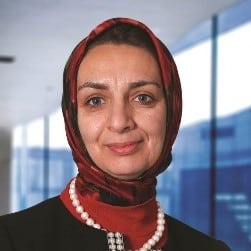 This month’s PNA Spotlight shines on Luma Ghalib, MD, F.A.C.E., a professional member of the PNA and an esteemed endocrinologist at The Ohio State University. Dr. Ghalib attended medical school at Baghdad University and completed a residency in internal medicine at Medical City Teaching Hospital in Baghdad. She then moved with her husband to New Zealand, where she did her initial training at Auckland Healthcare. She did a second residency in internal medicine at the Medical College of Ohio. Dr. Ghalib finished her endocrinology fellowship training at Chicago Medical School, part of Rosamund Franklin University. She then worked with Mary Washington Healthcare in Virginia as a consultant endocrinologist. Dr. Ghalib joined The Ohio State University in 2013 and she worked closely with neurosurgery and the ENT team to create a state-of-the-art Skull Base and Pituitary Clinic. She is currently an Assistant Professor in the Division of Endocrinology, Diabetes and Metabolism at The Ohio State University. She was kind enough to answer some questions from the PNA:
This month’s PNA Spotlight shines on Luma Ghalib, MD, F.A.C.E., a professional member of the PNA and an esteemed endocrinologist at The Ohio State University. Dr. Ghalib attended medical school at Baghdad University and completed a residency in internal medicine at Medical City Teaching Hospital in Baghdad. She then moved with her husband to New Zealand, where she did her initial training at Auckland Healthcare. She did a second residency in internal medicine at the Medical College of Ohio. Dr. Ghalib finished her endocrinology fellowship training at Chicago Medical School, part of Rosamund Franklin University. She then worked with Mary Washington Healthcare in Virginia as a consultant endocrinologist. Dr. Ghalib joined The Ohio State University in 2013 and she worked closely with neurosurgery and the ENT team to create a state-of-the-art Skull Base and Pituitary Clinic. She is currently an Assistant Professor in the Division of Endocrinology, Diabetes and Metabolism at The Ohio State University. She was kind enough to answer some questions from the PNA:
What inspired you to choose your career path?
I wish I had a fancy story to share, but I admit I followed my older sister’s path to become a physician and start medical school. Once I started my clinical rotation and got to talk to patients and their families, I knew that was where I wanted to spend the rest of my career. Picking endocrinology was easy. It is so logical and follows precise pathways that can be understood if you look hard and connect the dots. The pituitary gland makes most of the body’s hormones, which makes pituitary disease more challenging but also more rewarding to treat.
What is the primary focus of your work/research?
We handle a variety of cases in the comprehensive multidisciplinary Pituitary – Skull Base Clinic at the Ohio State University. We have a high volume of patients with malignant and benign lesions in the sellar area at the James Cancer Hospital. I work closely with neurosurgery, neuro- oncology, neuro-ophthalmology and ENT teams to provide comprehensive care for the patients and their families. The center has been involved with multiple trials evaluating the efficacy and safety of emerging treatments for Cushing’s and acromegaly.
What do you consider to be the future of your field?
There are several interesting and exciting treatments in the pipeline for functioning pituitary adenomas like Cushing’s and acromegaly. Cracking the genetic code, mutations will be the next big thing coming down the pike. I know we are not there, yet. But working at the James Cancer Hospital with my oncology colleagues, and seeing the advances in the oncology world – nothing seems impossible.
What should patients know about your field/what deserves more recognition/awareness?
Working in a big center makes me forget at times how rare some of the pituitary diseases are. We take care of patients who struggled for years before someone thought about the possibility of a pituitary-related illness. I believe that knowledge is power and it is great to be your own advocate. Many of the symptoms can be vague, slowly progressive and can be easily misdiagnosed.
Educating patients is great, but it is just as important to raise awareness in the medical community, which is comprised of people with different backgrounds. I take every opportunity to teach our medical students and residents what to expect and what to look for.
What would you like to convey about yourself to your patients?
It is my privilege to take care of them. They teach me as much as I teach them. By sharing their stories and struggles, they open my eyes to how many different ways the same illness can present. As we say here at the Ohio State University, no two people are the same.
Why did you get involved with the PNA and what is the extent of your involvement?
I have to thank my neurosurgery colleague Dr. Prevedello, who introduced me to the PNA many years ago. Since then, I try to keep active with a great, fun team at the PNA. I have presented webinars and answered members’ questions when needed. I am looking forward to working with the team to have another pituitary symposium at the Ohio State University in the future.
